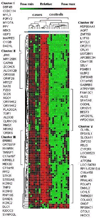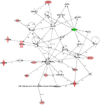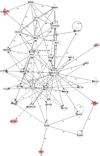Expression and methylation in posttraumatic stress disorder and resilience; evidence of a role for odorant receptors
- PMID: 27526315
- PMCID: PMC5148136
- DOI: 10.1016/j.psychres.2016.07.045
Expression and methylation in posttraumatic stress disorder and resilience; evidence of a role for odorant receptors
Abstract
Post-traumatic stress disorder (PTSD) is a common and potentially disabling disorder that develops in 1/5 to 1/3 of people exposed to severe trauma. Twin studies indicate that genetic factors account for at least one third of the variance in the risk for developing PTSD, however, the specific role for genetic factors in the pathogenesis of PTSD is not well understood. We studied genome-wide gene expression and DNA methylation profiles in 12 participants with PTSD and 12 participants who were resilient to similar severity trauma exposure. Close to 4000 genes were differentially expressed with adjusted p<0.05, fold-change >2, with all but 3 upregulated with PTSD. Eight odorant/olfactory receptor related genes were up-regulated with PTSD as well as genes related to immune activation, the Gamma-Aminobutyric Acid A (GABAA) receptor, and vitamin D synthesis. No differences with adjusted significance for DNA methylation were found. We conclude that increased gene expression may play an important role in PTSD and this expression may not be a consequence of DNA methylation. The role of odorant receptor expression warrants independent replication.
Keywords: Biomarker; Epigenetic; GABAA receptor; Microarray; Odorant receptor; Vitamin D Synthesis.
Copyright © 2016 Elsevier Ireland Ltd. All rights reserved.
Figures






Similar articles
-
[Posttraumatic stress disorder (PTSD) as a consequence of the interaction between an individual genetic susceptibility, a traumatogenic event and a social context].Encephale. 2012 Oct;38(5):373-80. doi: 10.1016/j.encep.2011.12.003. Epub 2012 Jan 24. Encephale. 2012. PMID: 23062450 Review. French.
-
A Systematic Review of DNA Methylation and Gene Expression Studies in Posttraumatic Stress Disorder, Posttraumatic Growth, and Resilience.J Trauma Stress. 2020 Apr;33(2):171-180. doi: 10.1002/jts.22472. Epub 2020 Jan 17. J Trauma Stress. 2020. PMID: 31951051
-
Integrated genetic, epigenetic, and gene set enrichment analyses identify NOTCH as a potential mediator for PTSD risk after trauma: Results from two independent African cohorts.Psychophysiology. 2020 Jan;57(1):e13288. doi: 10.1111/psyp.13288. Epub 2018 Oct 17. Psychophysiology. 2020. PMID: 30328613 Free PMC article.
-
Prominent genetic variants and epigenetic changes in post-traumatic stress disorder among combat veterans.Mol Biol Rep. 2024 Feb 23;51(1):325. doi: 10.1007/s11033-024-09276-0. Mol Biol Rep. 2024. PMID: 38393604 Review.
-
A review of epigenetic contributions to post-traumatic stress disorder .Dialogues Clin Neurosci. 2019 Dec;21(4):417-428. doi: 10.31887/DCNS.2019.21.4/kressler. Dialogues Clin Neurosci. 2019. PMID: 31949409 Free PMC article. Review.
Cited by
-
Internal State: Dynamic, Interconnected Communication Loops Distributed Across Body, Brain, and Time.Integr Comp Biol. 2021 Oct 4;61(3):867-886. doi: 10.1093/icb/icab101. Integr Comp Biol. 2021. PMID: 34115114 Free PMC article.
-
A Review of Epigenetics of PTSD in Comorbid Psychiatric Conditions.Genes (Basel). 2019 Feb 13;10(2):140. doi: 10.3390/genes10020140. Genes (Basel). 2019. PMID: 30781888 Free PMC article. Review.
-
Genome-wide differentially methylated genes associated with posttraumatic stress disorder and longitudinal change in methylation in rape survivors.Transl Psychiatry. 2021 Nov 19;11(1):594. doi: 10.1038/s41398-021-01608-z. Transl Psychiatry. 2021. PMID: 34799556 Free PMC article.
-
DNA methylation correlates of PTSD: Recent findings and technical challenges.Prog Neuropsychopharmacol Biol Psychiatry. 2019 Mar 2;90:223-234. doi: 10.1016/j.pnpbp.2018.11.011. Epub 2018 Nov 30. Prog Neuropsychopharmacol Biol Psychiatry. 2019. PMID: 30503303 Free PMC article. Review.
-
Association between gene methylation and experiences of historical trauma in Alaska Native peoples.Int J Equity Health. 2023 Sep 8;22(1):182. doi: 10.1186/s12939-023-01967-7. Int J Equity Health. 2023. PMID: 37679827 Free PMC article.
References
-
- Apfelbach R, Blanchard CD, Blanchard RJ, Hayes RA, McGregor IS. The effects of predator odors in mammalian prey species: a review of field and laboratory studies. Neurosci. Biobehav. Rev. 2005;29:1123–1144. - PubMed
-
- Baker DG, Nievergelt CM, O'Connor DT. Biomarkers of PTSD: Neuropeptides and immune signaling. Neuropharmacology. 2012;62:663–673. - PubMed
-
- Blake DD, Weathers FW, Nagy LM, Kaloupek DG, Gusman FD, Charney DS. The development of a clinician-administered PTSD scale. J. Trauma. Stress. 1995;8:75–90. - PubMed
-
- Boasso AM, Steenkamp MM, Nash WP, Larson JL, Litz BT. The Relationship Between Course of PTSD Symptoms in Deployed US Marines and Degree of Combat Exposure. J. Trauma. Stress. 2015;28:73–78. - PubMed
MeSH terms
Substances
Grants and funding
LinkOut - more resources
Full Text Sources
Other Literature Sources
Medical

